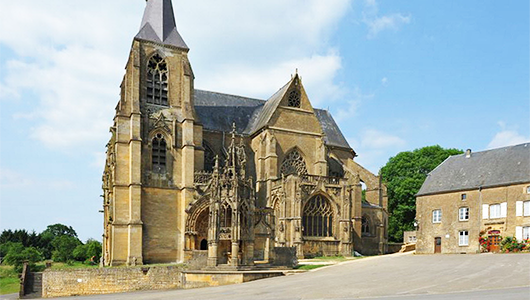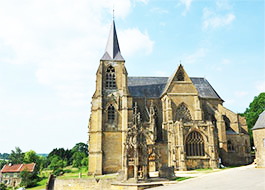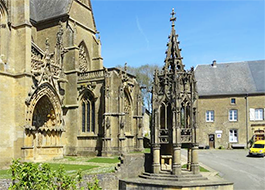Avioth
Durée visite : 30 minutes
Moyen : Pédestre
En 1223, Avioth est la première commune du comté de Chiny à obtenir la charte d’affranchissement, dite de Beaumont. Avioth avait donc déjà un maire et un tribunal échevinal. Ils recevaient les actes de vente et donation de biens situés sur son territoire . Elle abrite l’atelier monétaire des comtes. Elle doit son développement à une statue en bois d’une Vierge à l’Enfant. Cette découverte date du XIIe siècle. Dès lors le village fut un important lieu de pèlerinage. Dépendante des Pays -Bas espagnols, qui lui accorde un marché hebdomadaire et cinq foires annuelles, Avioth passe à la France en 1659. Réputée pour sa pierre, elle abritait des carriers qui pavèrent Montmédy au XIXe.
In 1223, Avioth was the first commune in the county of Chiny to obtain the charter of franking, known as Beaumont. Avioth therefore already had a mayor and an alderman tribunal. They received the deeds of sale and donation of goods located in its territory. It shelters the monetary workshop of the counts. It owes its development to a wooden statue of a Madonna and Child. This discovery dates from the 12th century. From then on the village was an important place of pilgrimage. Dependent on the Spanish Netherlands, which grants it a weekly market and five annual fairs, Avioth moved to France in 1659. Renowned for its stone, it housed quarrymen who paved Montmédy in the 19th century.
Im Jahr 1223 erhielt Avioth als erste Gemeinde in der Grafschaft Chiny die als Beaumont bekannte Frankierurkunde. Avioth hatte daher bereits einen Bürgermeister und ein Alderman Tribunal. Sie erhielten die Kauf- und Spendenurkunden für Waren in ihrem Hoheitsgebiet. Es beherbergt die Geldwerkstatt der Grafen. Es verdankt seine Entwicklung einer Holzstatue einer Madonna und eines Kindes. Diese Entdeckung stammt aus dem 12. Jahrhundert. Von da an war das Dorf ein wichtiger Wallfahrtsort. In Abhängigkeit von den spanischen Niederlanden, die ihm einen Wochenmarkt und fünf jährliche Messen gewähren, zog Avioth 1659 nach Frankreich. Bekannt für seinen Stein, beherbergte er Steinbrüche, die Montmédy im 19. Jahrhundert pflasterten.

Les habitants d’Avioth s’appellent les Aviothois et les Aviothoises.
The inhabitants of Avioth are called the Aviothois and the Aviothoises.
Die Einwohner von Avioth heißen Aviothois und Aviothoises.
Les points de visites
.
Cette église gothique est construite à partir du XIIIe siècle à la place d’un ancien oratoire dédié à la Vierge. La découverte d’une statue de celle-ci avait conduit à un important pèlerinage au XIIe. L’église fortifiée sert de refuge pendant les guerres de religion et le conflit franco-espagnol. Ne manquez pas les sculptures des portails méridional et occidental. Le magnifique buffet d’orgue signé Boizard date de 1717. La statue de Notre-Dame du XIIe siècle est l’objet d’un pèlerinage tous les 16 juillet. Admirez la dentelle de la tour eucharistique du XVe qui contient le tabernacle. Derrière la maître-autel se trouve le gisant de Catherine de Breux, dont la famille fournit le terrain pour la construction de l’église. En 1993, Jean Paul II éleva celle-ci au rang de basilique.
This Gothic church was built from the 13th century in place of an old oratory dedicated to the Virgin. The discovery of a statue of it had led to an important pilgrimage in the 12th century. The fortified church served as a refuge during the wars of religion and the Franco-Spanish conflict. Do not miss the sculptures of the southern and western portals. The magnificent organ case signed Boizard dates from 1717. The 12th century statue of Notre-Dame is the object of a pilgrimage every July 16. Admire the lacework of the 15th century Eucharistic tower that contains the tabernacle. Behind the high altar is the recumbent statue of Catherine de Breux, whose family provided the land for the construction of the church. In 1993, John Paul II elevated it to the rank of basilica.
Diese gotische Kirche wurde ab dem 13. Jahrhundert anstelle eines alten Oratoriums erbaut, das der Jungfrau gewidmet ist. Die Entdeckung einer Statue davon hatte im 12. Jahrhundert zu einer wichtigen Pilgerreise geführt. Die befestigte Kirche diente während der Religionskriege und des französisch-spanischen Konflikts als Zuflucht. Verpassen Sie nicht die Skulpturen der südlichen und westlichen Portale. Der prächtige Orgelkoffer mit der Unterschrift Boizard stammt aus dem Jahr 1717. Die Statue von Notre-Dame aus dem 12. Jahrhundert ist jedes Jahr am 16. Juli Gegenstand einer Pilgerreise. Bewundern Sie die Spitzen des eucharistischen Turms aus dem 15. Jahrhundert, in dem sich die Stiftshütte befindet. Hinter dem Hochaltar befindet sich die liegende Statue von Catherine de Breux, deren Familie das Land für den Bau der Kirche zur Verfügung stellte. Im Jahr 1993 erhob Johannes Paul II. Es in den Rang einer Basilika.
.
.
La Recevresse est un monument unique au monde. Ce chef-d’œuvre du gothique flamboyant a vraisemblablement été construit à l’endroit de la découverte de la statue miraculeuse. La légende l’attribue à un diablotin jaloux d’avoir été écarté de la construction de l’église. Au début du XIVe siècle, lorsque la statue de Notre-Dame d’Avioth put entrer dans son église, une autre statue de la Vierge prit sa place pour recevoir, en son nom, les offrandes des pèlerins. Ils apportaient du blé, des cierges, du linge, de l’argent, des animaux. On appela cette statue: la Vierge Recevresse. Avec le temps, ce nom fut donné au monument. Au XVIe siècle, des chaînes de fer ont été placées au dessus de la statue par des esclaves, en signe de reconnaissance pour leur délivrance du joug turc. Les armoiries sur le mur sont celles de Gilles de Rodemack, prévôt de Montmédy et gouverneur du Luxembourg au XVe.
La Recevresse is a unique monument in the world. This Flamboyant Gothic masterpiece was probably built on the site of the discovery of the miraculous statue. The legend attributes it to an imp jealous of having been excluded from the construction of the church. At the beginning of the 14th century, when the statue of Our Lady of Avioth was able to enter her church, another statue of the Virgin took her place to receive, in her name, the offerings of the pilgrims. They brought wheat, candles, linen, money, animals. This statue was called: the Virgin Recevresse. Over time, this name was given to the monument. In the 16th century, iron chains were placed above the statue by slaves, as a sign of gratitude for their deliverance from the Turkish yoke. The coat of arms on the wall is that of Gilles de Rodemack, provost of Montmédy and governor of Luxembourg in the 15th century.
La Recevresse ist ein weltweit einzigartiges Denkmal. Dieses Meisterwerk der extravaganten Gotik wurde wahrscheinlich an der Stelle errichtet, an der die wundersame Statue entdeckt wurde. Die Legende schreibt es einem Kobold zu, der eifersüchtig ist, vom Bau der Kirche ausgeschlossen worden zu sein. Zu Beginn des 14. Jahrhunderts, als die Statue Unserer Lieben Frau von Avioth ihre Kirche betreten konnte, trat eine weitere Statue der Jungfrau an ihre Stelle, um in ihrem Namen die Opfergaben der Pilger zu empfangen. Sie brachten Weizen, Kerzen, Leinen, Geld und Tiere. Diese Statue wurde genannt: die Recevresse Jungfrau. Im Laufe der Zeit wurde dem Denkmal dieser Name gegeben. Im 16. Jahrhundert wurden Eisenketten von Sklaven als Zeichen der Dankbarkeit für ihre Befreiung vom türkischen Joch über die Statue gelegt. Das Wappen an der Wand ist das von Gilles de Rodemack, Provost von Montmédy und Gouverneur von Luxemburg im 15. Jahrhundert.







